
Content marketing is all about showcasing what makes you unique. When you’re throwing an event, the different aspects of the event are what you’ll want to highlight. This could be any combo of the following: bands, artists, drinks special, sponsors, location, cause, etc. These are the things that you want your audience to know more about.
NCC and Kelcie McQuaid of Shangri-La Creations collaborated to create a Fort Lauderdale arts and music festival called LIMITLESS. The event was meant to highlight some of the best South Florida-based artists and musicians. Our goal was to get as many paying attendees as possible (we were making money from the door), while increasing networking and exposure of artists. We planned on attracting attendees by creating awareness of the event through the spread of our content leading up to the day. The event consisted of 5 bands, 20 artists, 5 DJs, and 5 sponsors (including NCC)– a packed lineup to say the least. For the sake of my sanity, I’ll refer to all the bands, DJs, artists, and sponsors, simply as “the participants”.
Before I Dive In…
I want to make a few things clear before you jump to any conclusions:
FIRST THING: You don’t need to have 30 artists to mimic our strategy. As little as 1 will suffice. Example: Big Sean is performing at your venue, write about Big Sean– that’s just 1 artist.
SECOND THING: I’m not trying to pretend that this strategy is unique or genius. Guess what? You don’t need to have a complex, mega-creative plan to have an highly effective content marketing strategy. If you’re Coca Cola, maybe you can afford to be extravagant, but for most, what you’re about to read will work for your event.
THIRD THING: We made a little bit of money on the event (with each of us putting in 20+ hours leading up to the event), but for the most part, this was a party for the betterment of the community. We had no ads budget, limited time, and no guarantee of any compensation. We maximized and prioritized the time and resources that we had for this event. If this was more of a for-profit venture, we would’ve invested more time and money into different types of content and paid distribution.
Without further adieu…
Our Content Marketing Strategy for LIMITLESS
Our content marketing strategy was straight-forward
- Create 1 piece of content on every participant
- Distribute that content through each participant’s network
Generally speaking, the above can be the 2-step framework for any event.
What content were we going to create?
We had A LOT of performers and artists involved in this event, and we wanted to create content for each of them. There’s a couple of reasons why creating content for each performer was crucial to our strategy:
- It allowed potential attendees to learn about every artist on the bill
- It encouraged the artists to share (everyone likes getting content about themselves)
- It encouraged artists to agree to be part of the event (for the record, they also got paid)
Time was limited, so we needed to quickly pump out lots of content with hopes of going locally viral.
What medium?
We decided on 2 mediums for our content:
- Written content in the form of an interview with mixed media embedded (a song or image of their art)
- A custom flyer for each artist
The interview questions were emailed to each artist 6 weeks ahead of time. Every participant received the same questions, plus 1 or 2 unique questions specific to them. Each interview blog post followed the same format:
- Intro
- The Q&A
- Mixed media
- The conclusion with link to the Facebook Event.
Essentially, the participant was writing most of the content– we just added an intro, outro, and some editing. This streamlined system allowed us to produce 30 pieces of quality content in a relatively short amount of time.
The custom flyers all used the same Photoshop template– Kelcie just swapped out the image. Using the PSP template allowed us to quickly make 30 versions of the flyer.
Here’s a custom flyer for LIMITLESS artist Christopher Ian MacFarlane…
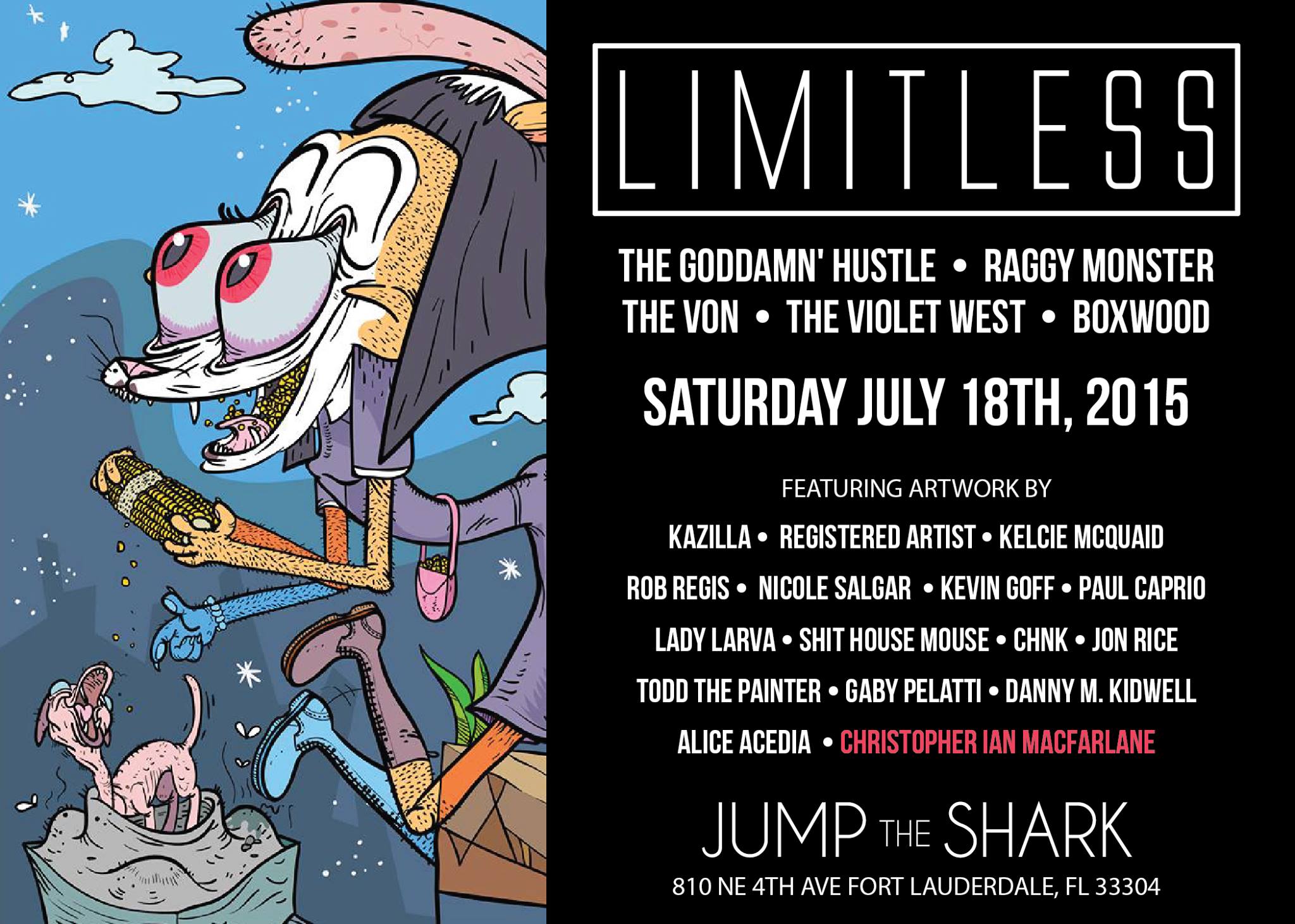
(creating by Shangri-La Creations)
Where were we going to host the content?
We decided to create a simple website for the festival to host the content. We chose this avenue for several reasons:
- It allowed us to own our content
- It allowed us to track the success of our content
- It made the festival LARGER-THAN-LIFE
The website was made as minimalistic as possible. The homepage was the lineup (with images of each performer), with links to each artist’s interview, the Facebook event, and an About page that described the event in more detail. Our partner Shangri-La made the logo. Because it was a no-frills site, the time investment to create it was relatively small (again, our time was limited).
Unfortunately, the website is no longer live (RIP), but these screenshots should give you an idea of the site’s look and feel.
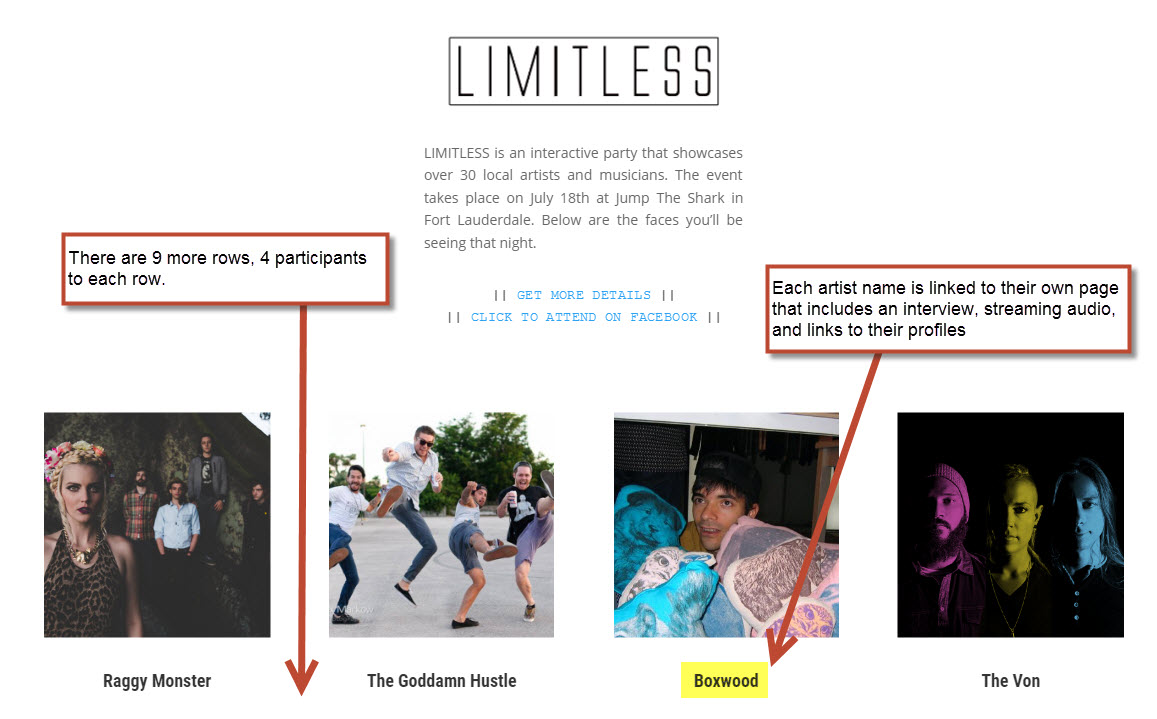
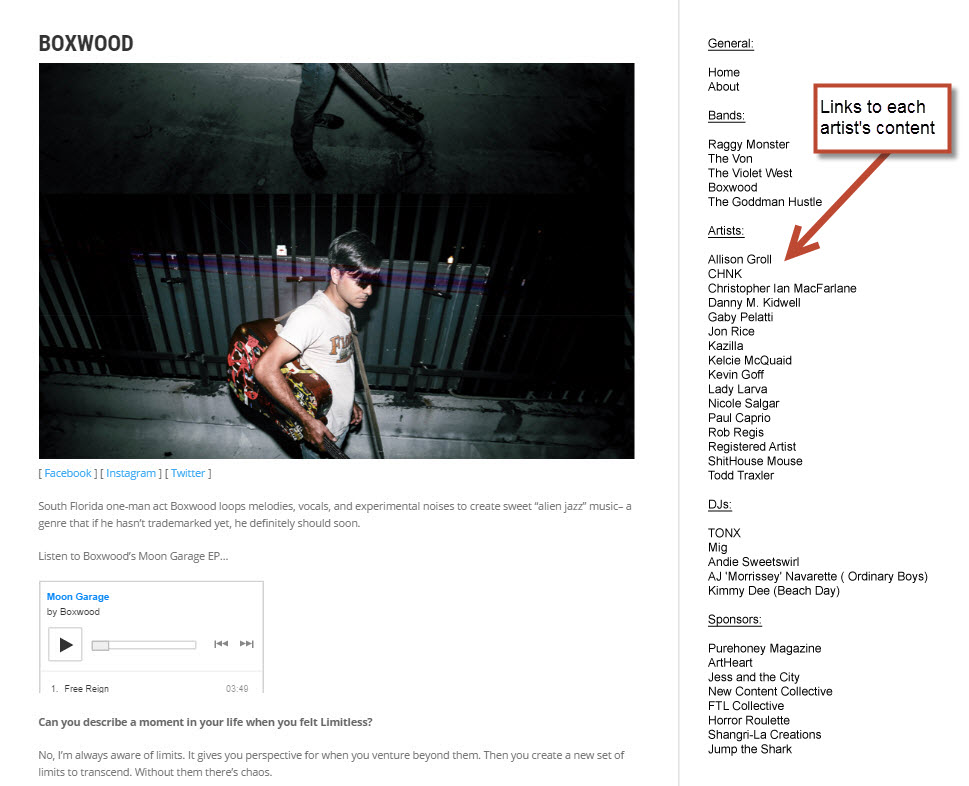
Note: If we were selling tickets in advance, we’d also be sure to include a section for purchasing tickets. If we were utilizing email marketing, we would’ve had an opt-in (but we didn’t start marketing until 4 weeks in advance– not enough time to build a list and market to it).
What kind of distribution?
As mentioned earlier, we were banking on the event’s participants to spread our content to their own networks– primarily their social media channels. Because we created content specific to each participant, we expected that at the very least, everyone would share their own content. We hoped that some of them would share other content that wasn’t just about them.
Since we were dealing with links and imagery (the custom flyers), we predicted that most of our content would go viral on Facebook, Twitter, and Instagram (the images).
Beyond the interviews and images, we distributed the festival website link to all major local event listings.
Our Content Schedule
All the content was created and published on the festival site a month in advance. Our plan was to distribute the content on our own channels (NCC, Shangri-La, and a few other entities we controlled) evenly over those 30 days.
Finding the perfect publishing frequency is always key. For us, it was no more than 2 new pieces of content per day, leading up to the event. This level of frequency made it so that the party was always being talked about online, without being spammy. The order of distribution went in the order that the participants returned our interview questions with their answers.
Meanwhile, the participants were sharing their own content throughout that whole month– most of them sharing their interview multiple times. These shares were not on a schedule, and that worked just fine. As a bonus, some of the participants shared the posts from NCC and Shangri-La’s channels.
Measuring Our Success
If we were selling tickets in advance, collecting emails, or building festival-specific social media channels all in addition to building awareness for the party, we’d have multiple metrics to look at. That wasn’t the case though.
We pretty much paid attention to 3 things:
- traffic to the event website
- Facebook event attendees
- actual people that paid to party
In theory, the actual number of people (bulletpoint 3) was a result of bulletpoints 1 and 2. Impressions were key as well, but they were hard to measure since the bulk of impressions were coming from channels that we couldn’t control (the artists).
The Content After the Event
Post-event content is normally a great way to keep the momentum going, but since this was a one-time event, it wasn’t as important.
If we were to create content after the event, these are the types of post-event content we would’ve made:
- Photos
- Video
- Written reviews (ex: writing about the show)
- Audio (ex: live music from the event, pre-show interviews with bands, etc)
- Attendee testimonials (ex: “Best event ever!” – Joe)
- Attendee-generated content (ex: attendee Instagram pics, tweets, etc)
We didn’t really talk much about post-event content, but we ended up taking some video timelapses and photos. Here’s one I did from behind one of the stages.
My camcorder battery died after about an hour and half. The whole event lasted 6 hours. Also, this was just 1 of the 3 rooms at Jump The Shark. Song by one of the performers, The Von.
The Results of our Content Marketing Efforts
The event was a success!
Here were some of the metrics we recorded:
- 750 attendees (give or take)
- 2002 website visits (6/19 – 7/18)
- 343 “wents” on Facebook (17K impressions)
Here are some screenshots of the stats…
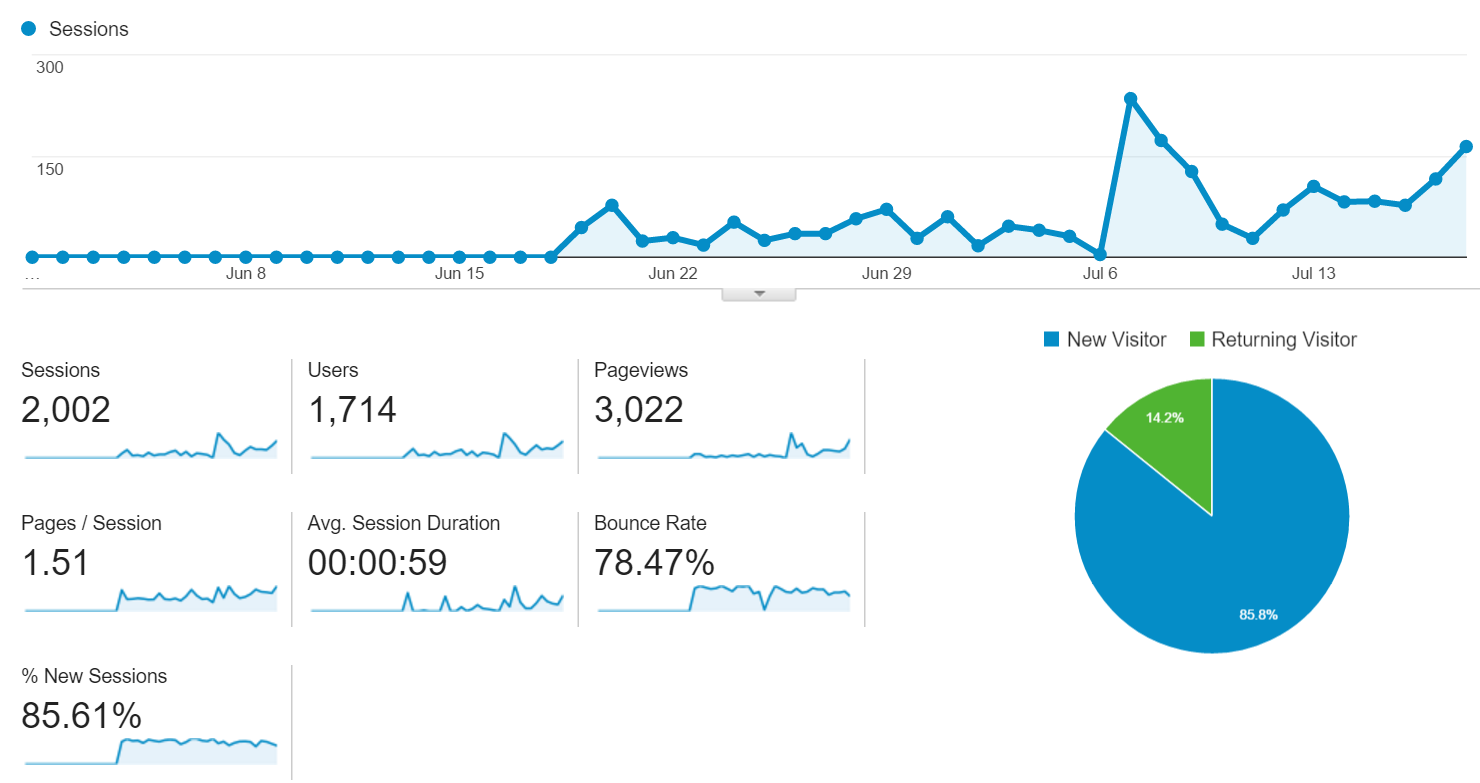
This is Google Analytics from June 19th when the first piece of content was published, until the July 18th, when the event took place. Not shown here is 300+ visits that occurred a few days after the event.
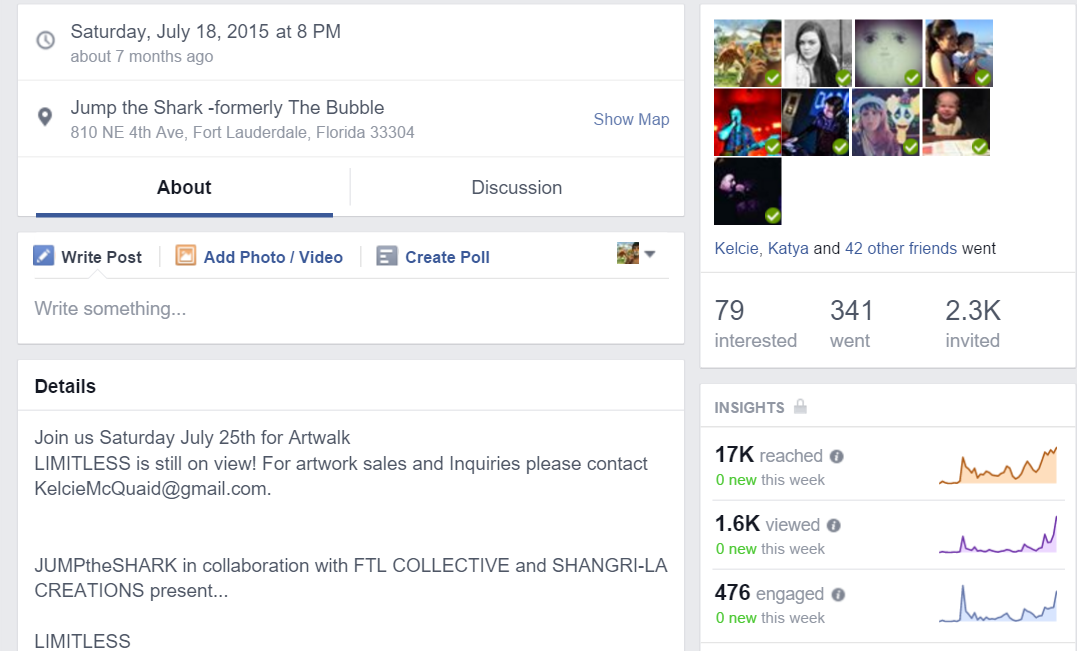
Look at the bottom right for the key stats.
Things You Could Tweak
Every event is different, so tweak your strategy to reflect what makes your party special. Here are a few things you can alter:
- the type of content
- the frequency of distribution
- the medium
- the length of time to market
- the metrics you track
Things You Could Add
Our strategy was stripped down to the basics for multiple reasons. We prioritized the things that were most important to creating a successful event with no budget and limited time.
In a perfect world, you would add any of the following:
- Digital ads
- Advanced tickets
- More content
- Email marketing
- Rewards for participants who promote the most
- PR
- Repurposing content
- Guest blogging
Conclusion
I wrote this post to give you a stripped-down version of an event’s content marketing strategy. If you’re business is having an event, use this as a guide to get started.
Your event’s most important content topics are:
- the theme
- the performers/artists
- the perks (ex: food, booze, free stuff)
- the location
So write about those things. Write about the reasons why those things are special (ex: awesome bands, new vodka brand, historic venue, interesting theme, etc). Then make sure it gets distributed.
If you do a lot of events, repeat and repeat and repeat.
Need help? Feel free to email me. I and/or Kelcie from Shangri-La can help you with your event’s content marketing.
